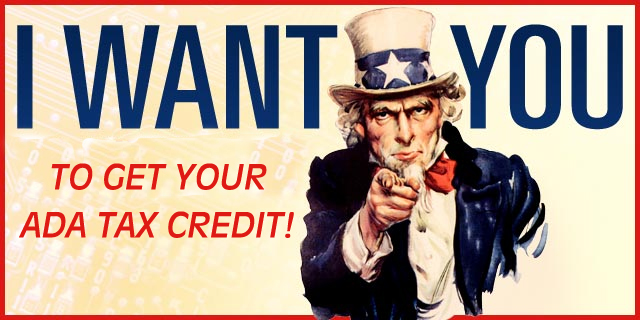Friends of SafePath:
As the end of the year approaches we wanted to share some valuable and often misunderstood tax credit information that equates to real dollars to you and your customers. This is a great way to reach out and stay in touch with your customers while relaying valuable financial tax information.
Federal tax credits are available to “eligible small businesses” in the amount of 50% for “eligible access expenditures” for the taxable year that exceeds $250.00 but does not exceed $10,250.00 per year. An “eligible business” is any business or person that has 30 employees or fewer.
The $1,000,000 requirement is for businesses that have 31 employees or more. This section has often been misinterpreted for many who thought that if they made more than $1,000,000 in gross receipts they were not eligible for this credit.
Eligible access expenditure examples include; removal of architectural barriers, providing Braille signage or providing other equipment for accessibility. To upgrade the transitions to your business please contact our sales team right away.
ADA Tax Credit FACT SHEET 4 Excerpt
Tax Incentives for Improving Accessibility
“Two tax incentives are available to businesses to help cover the cost of making access improvements.
The first is a tax credit that can be used for architectural adaptations, equipment acquisitions, and services such as sign language interpreters. The second is a tax deduction that can be used for architectural or transportation
adaptations.
(NOTE: A tax credit is subtracted from your tax liability after you calculate your taxes, while a tax deduction is subtracted from your total income before taxes, to establish your taxable income.)
ADA Tax Credit
The tax credit, established under Section 44 of the Internal Revenue Code, was created in 1990 specifically to help small businesses cover ADA-related “eligible access expenditures.
” A business that for the previous tax year had either revenues of $1,000,000 or less or 30 or fewer full-time workers may take advantage of this credit. The credit can be used to cover a variety of expenditures, including:
provision of readers for customers or employees with visual disabilities provision of sign language interpreters
purchase of adaptive equipment production of accessible formats of printed materials (i.e., braille, large print, audio tape, computer diskette) removal of architectural barriers in facilities or vehicles (alterations must comply
with applicable accessibility standards) fees for consulting services (under certain circumstances).
Note that the credit cannot be used for the costs of new construction. It can be used only for adaptations to existing facilities that are required to comply with the ADA.
The amount of the tax credit is equal to 50% of the eligible access expenditures in a year, up to a maximum expenditure of $10,250. There is no credit for the first $250 of expenditures. The maximum tax credit, therefore, is $5,000.
Tax Deduction
The tax deduction, established under Section 190 of the Internal Revenue Code, is now a maximum of $15,000 per year—a reduction from the $35,000 that was available through December 31, 1990. A business (including
active ownership of an apartment building) of any size may use this deduction for the removal of architectural or transportation barriers. The renovations under Section 190 must comply with applicable accessibility standards.
Small businesses can use these incentives in combination if the expenditures incurred qualify under both Section 44 and Section 190. For example, a small business that spends $20,000 for access adaptations may take a tax
credit of $5000 (based on $10,250 of expenditures), and a deduction of $15,000.
The deduction is equal to the difference between the total expenditures and the amount of the credit claimed.
EXAMPLE: A small business’ use of both tax credit and tax deduction $20,000 cost of access improvements
(rest room, ramp, 3 doors widened) – $5,000 maximum credit $15,000 remaining for deduction.”
TIMOTHY VANDER HEIDEN, J.D., is CEO of SafePath Products and Van Duerr Industries, Inc. He has more than 25 years of experience marketing and manufacturing products for ADA compliance, specializing in green technology for the architectural marketplace. Tim and his team can be reached at 800.497.2003, or visit www.safepathproducts.com.
